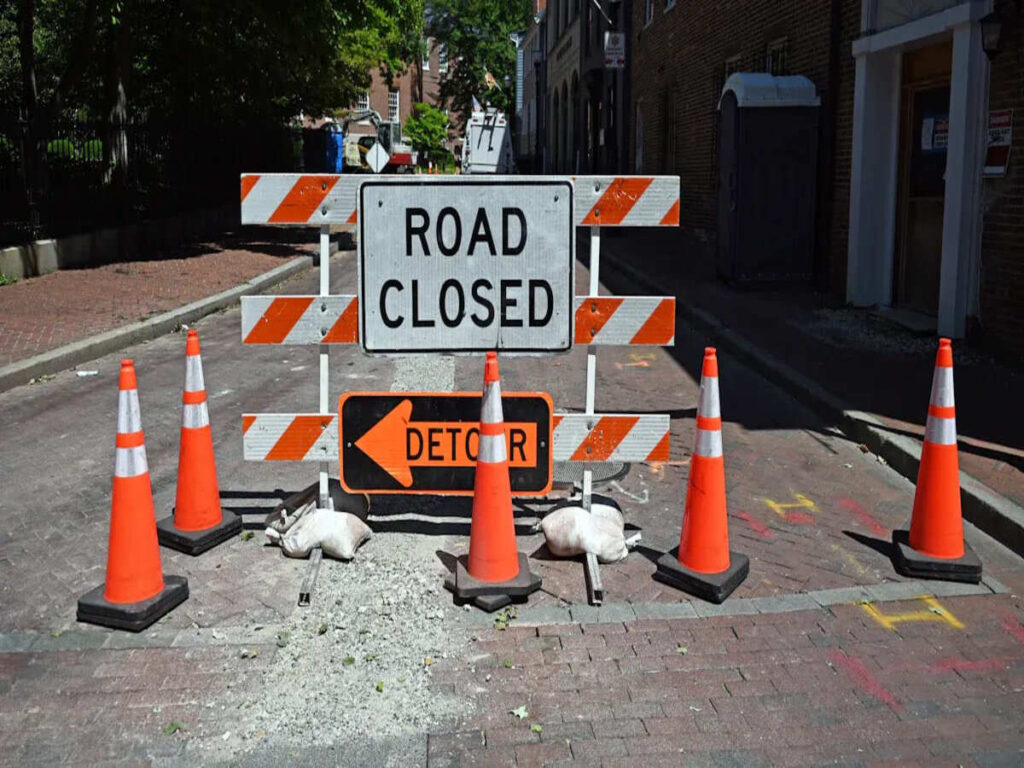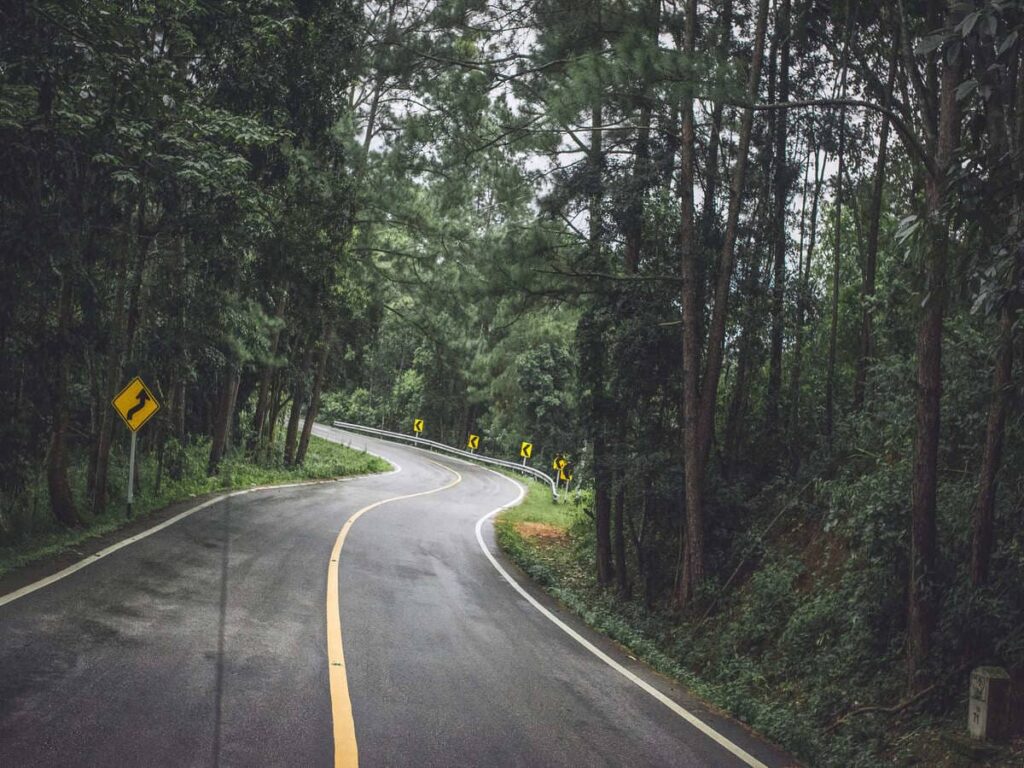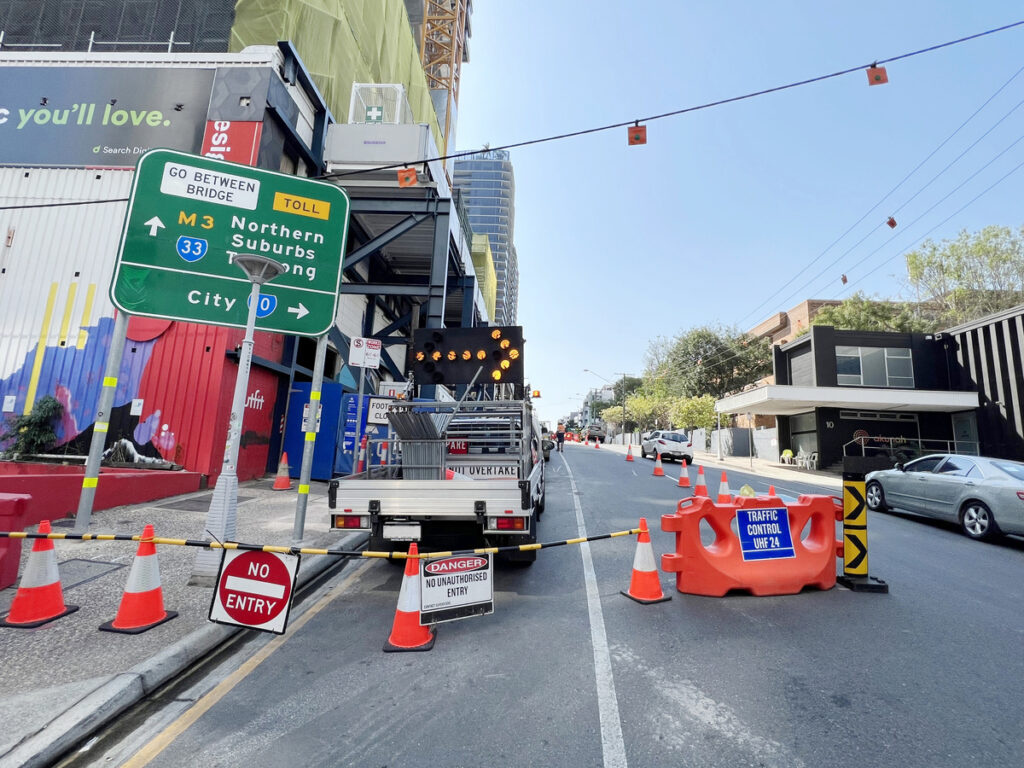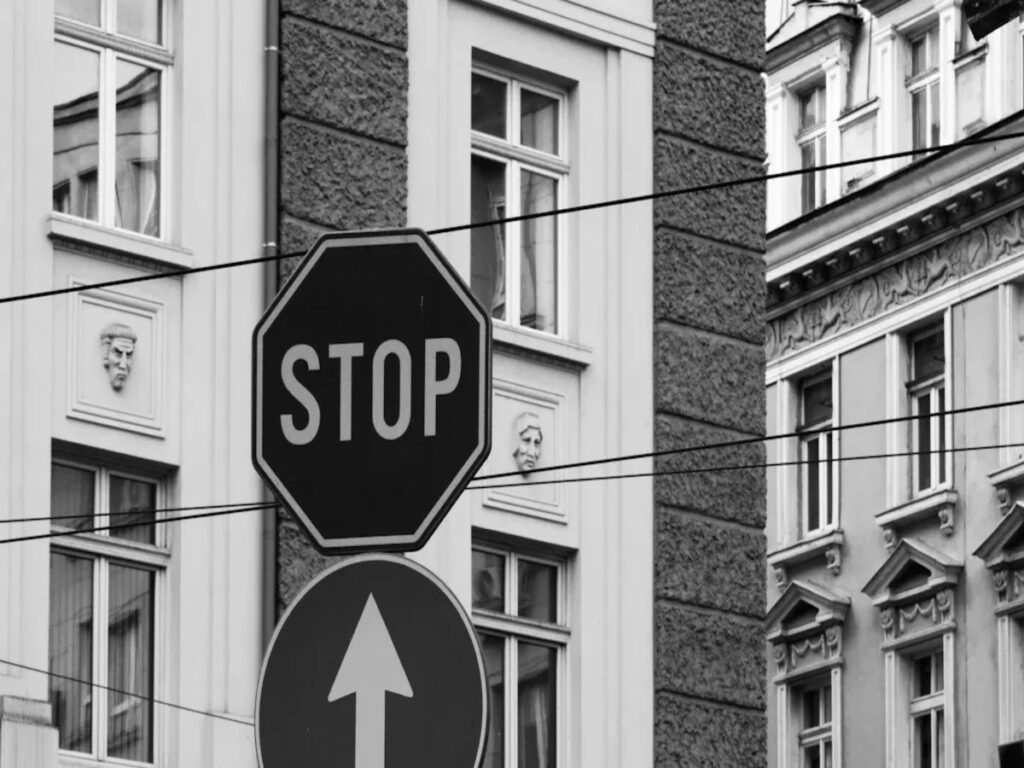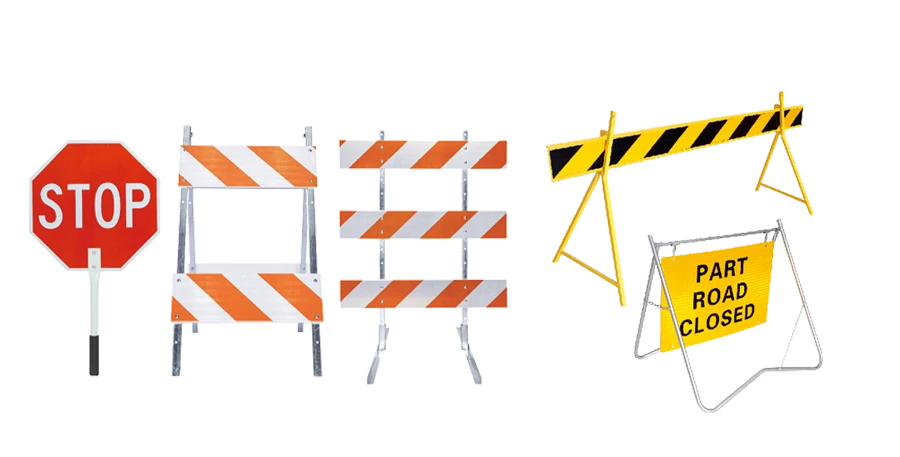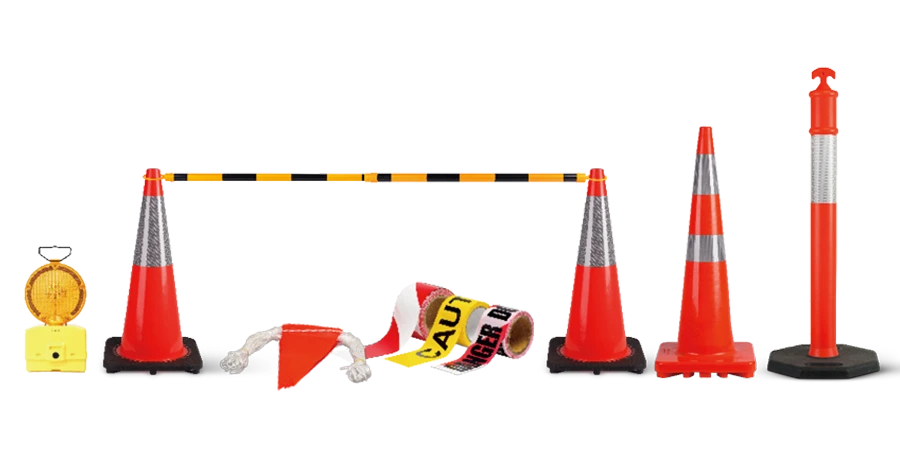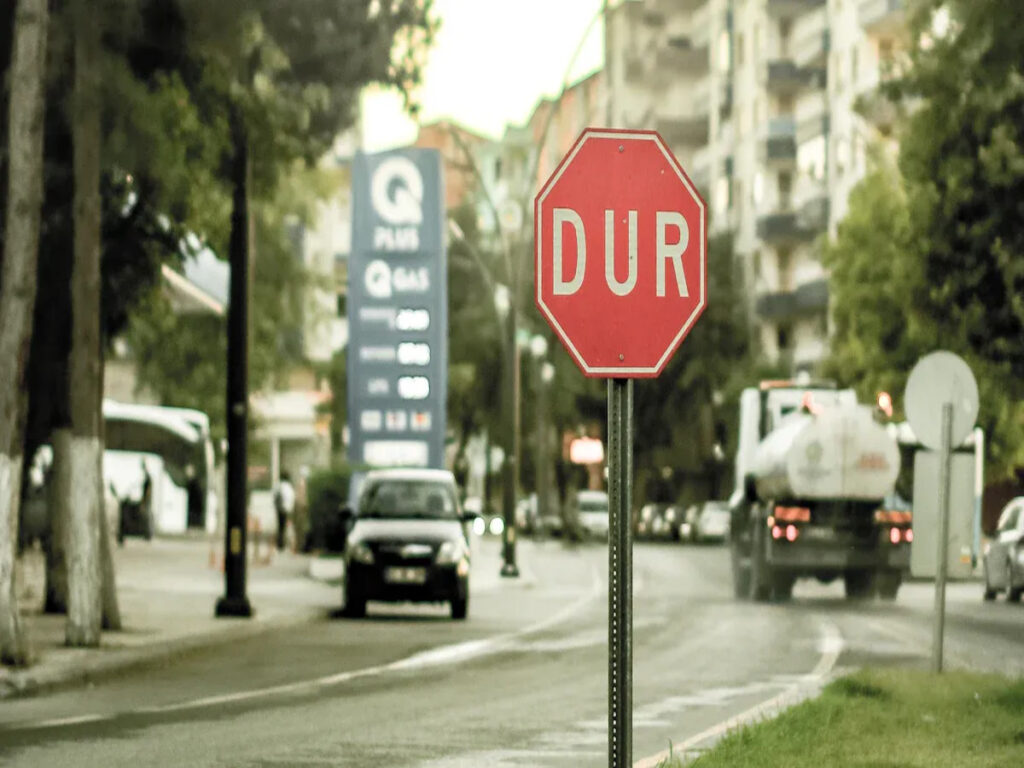
Señales de parada son muy importantes para la seguridad y el orden vial. La gente de todas partes sabe qué es una señal de parada. Pero su aspecto y sus palabras pueden cambiar en diferentes lugares. En Europa, Los letreros de parada son rojos y con forma de octágono. Tienen la palabra inglesa parada en ellos. Esto comenzó en la Segunda Guerra Mundial cuando el Ejército de los EE. UU. Usó este letrero en Europa.. La palabra parada es clara y ayuda a los conductores de muchos países a comprender. Usando la misma palabra, forma, y el color hace que las señales de parada europeas funcionen bien y fácil de ver.
OPTRAFFIC ofrece una variedad de alta calidad señales de parada que cumplen con los estándares internacionales de seguridad. Nuestras señales están diseñadas para máxima visibilidad y facilidad de comprensión., ayudando a garantizar la seguridad en las carreteras de todo el mundo. Explore nuestra gama hoy para mejorar la seguridad vial y el cumplimiento.
Señales de alto europeas: Diseño y Reconocimiento
Forma octogonal y color rojo.
Las señales de stop europeas son todas iguales. El Convención de Viena sobre letreros y señales de carretera (1968) hizo las reglas para ellos. La mayoría de las señales de alto en Europa tienen forma de octágono.. Tienen un fondo rojo y letras blancas que deletrean stop.. Esto los hace fáciles de ver en cualquier camino.. La forma octágono es especial y no como otras señales de tráfico.. Los conductores pueden detectarlo desde lejos o cuando hace mal tiempo..
| Aspecto de especificación | Descripción |
|---|---|
| Forma | Octagonal (a veces circular con un triángulo invertido rojo) |
| Color | Fondo rojo con letras blancas. |
| Letras | La palabra “DETENER” en letras blancas o amarillas |
| Base regulatoria | Convención de Viena (1968) |
| Variaciones | Algunos países utilizan señales circulares o fronteras diferentes. |
| Excepciones | El Reino Unido utiliza un cartel octogonal rojo con letras blancas |
El rojo significa peligro y hace que la gente preste atención.. Los estudios dicen que los conductores ven rápidamente las señales de alto rojas, Incluso por la noche. El rojo y el blanco juntos hacen que el letrero se destaque más.. Esto ayuda a los conductores a detenerse rápidamente. El color brillante y la forma ayudan a evitar accidentes en los cruces.. Estas características mantienen a todos seguros en las carreteras europeas.
Consejo: La forma de octágono ayuda a los conductores a saber que es una señal de alto., Incluso si la nieve o la tierra cubren las palabras..
Significado universal
Las señales de alto europeas utilizan la palabra alto. Los conductores de muchos países saben lo que significa. La Convención de Viena dice que la palabra puede estar en inglés o en el idioma local.. La mayoría de los países eligen detenerse porque está claro. Esto ayuda a los conductores que viajan entre países de Europa.. En lugares con muchos idiomas, el uso de stop detiene la confusión. Ayuda a que todos sigan las mismas reglas..
- Las señales de alto europeas se colocan donde más importa la seguridad, como cruces de caminos muy transitados o lugares donde es difícil ver.
- Usar Stop en todas partes significa que los conductores de diferentes lugares saben qué hacer, aunque no hablen el idioma.
- Las investigaciones muestran que señales como la señal de alto ayudan a los conductores a darse cuenta y reaccionar más rápido, que hace que las carreteras sean más seguras.
Las señales de stop europeas demuestran que un diseño sencillo y una palabra pueden salvar vidas y hacer que viajar sea más seguro para todos.
Por qué “DETENER” se utiliza
Normalización internacional
Los países europeos querían que las carreteras fueran más seguras para todos. Los conductores de muchos países cruzan a menudo las fronteras. Antes, cada país tenía sus propias señales de tráfico. Algunos carteles usaban palabras locales.. Otros tenían diferentes formas y colores.. Esto confundió a los conductores y provocó algunos accidentes..
Para arreglar esto, Los líderes acordaron una palabra y un diseño.. Eligieron detenerse porque es corto y fácil de ver.. La forma octágono y el color rojo ayudan a los conductores a notar la señal rápidamente.. Estas cosas hacen que la señal de alto sea diferente de otras señales..
Muchos expertos creen que usar la misma señal de alto ayuda a todos. Cuando los conductores ven el octágono rojo con parada, ellos saben que hacer. Esto reduce los errores y mantiene las carreteras seguras.. La misma señal de alto también ayuda a las personas que no hablan el idioma. Todavía pueden seguir las reglas..
Nota: Usar stop en inglés no siempre evita accidentes. Es posible que algunos conductores no lean bien el inglés. Pero la forma y el color ayudan a la mayoría de las personas a saber qué significa el letrero..
La Convención de Viena
La Convención de Viena ayudó a que las señales de alto fueran iguales en Europa. En 1968, Muchos países se reunieron en Viena para acordar normas sobre señales de tráfico.. Querían que las carreteras fueran más seguras y fáciles para todos. La Convención estableció reglas claras para el diseño y las palabras de las señales de alto..
A continuación se muestra una tabla que muestra las principales características de las señales de alto según lo establecido por la Convención de Viena.:
| Característica | Señal de stop octogonal | Señal de stop variante circular |
|---|---|---|
| Forma | Octágono | Círculo con triángulo invertido rojo en su interior. |
| Color de fondo | Rojo | Blanco o amarillo |
| Color del borde | Blanco | Rojo |
| Tamaño | 0.9 metro (grande), 0.6 metro (pequeño) | 0.9 metro (grande), 0.6 metro (pequeño) |
| Fraseología | parada en blanco | Deténgase en negro o azul oscuro dentro del triángulo invertido rojo. |
| Objetivo | Uniformidad internacional y reconocibilidad de la palabra stop para promover la seguridad y la coherencia a nivel internacional. |
Siguiendo estas reglas, Las señales de alto son iguales en todas partes de Europa.. Para junio 2004, 52 Los países habían firmado la Convención de Viena.. La mayoría de los países europeos utilizan estas reglas.. Esto ayuda a los conductores a saber qué esperar cuando viajan..
Using stop in English helps many drivers. Some accidents happen when drivers cannot read English. But most people agree the shape and colour help everyone understand. Drivers say knowing traffic signs, como señales de parada, es importante para la seguridad. Some think better language skills could help stop accidents. But the standard stop sign design already saves many lives.
Consejo: The Vienna Convention made stop signs easy to spot, even for people who do not speak English. The shape, color, and word work together to keep roads safe.
Cultural and Linguistic Factors
Language Diversity in Europe
Europe has many countries. Each country has its own language. People in Spain speak Spanish. People in Italy speak Italian. In Hungary, most people use Hungarian. Even with all these languages, stop signs look the same. La siguiente tabla muestra algunos ejemplos:
| País | Common Language(s) Spoken |
|---|---|
| Spain | Español |
| Italia | Italian |
| Romania | Romanian |
| Albania | Albanian |
| Hungary | Hungarian |
| Letonia | Latvian |
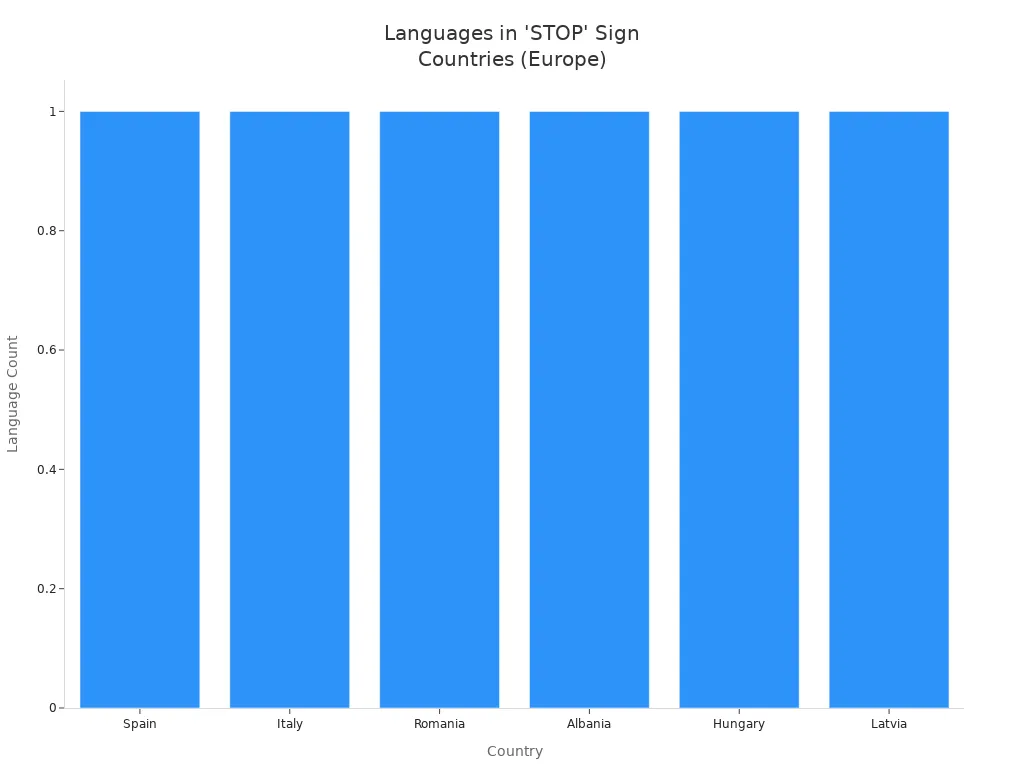
Todos estos países utilizan la palabra stop en sus carteles.. Esto ayuda a los conductores de otros lugares a saber qué hacer.. No necesitan hablar el idioma local..
Comparación con otras regiones
Otras partes del mundo usan palabras diferentes en las señales de alto. Muchos países fuera de Europa utilizan su propio idioma.. En Quebec, Canadá, las señales de alto dicen “detener”. En América Latina, algunas señales dicen “alto” o “cortar”y en asia, Japón usa “detener” (tomare). La siguiente tabla da más ejemplos:
| Región | País/área | Palabra local(s) en señales de alto |
|---|---|---|
| América Latina | Argentina, Brasil, Chile, etc.. | cortar |
| América Latina | México, Centroamérica | alto |
| Asia | Japón | detener (tomare) |
| Asia | Porcelana, Taiwán | detener (crédito) |
| América del norte | Canadá (Quebec) | detener |
| Oriente Medio | países de habla árabe | qaf (qif) |
Estas señales suelen parecerse a las señales de alto europeas.. Pero las palabras están en el idioma local.. Usar palabras locales ayuda a las personas que viven allí.. Pero puede confundir a los visitantes.. En Europa, usar una palabra ayuda a que todos entiendan.
Algunos países europeos tienen áreas con más de un idioma.. Algunos lugares utilizan carteles con dos idiomas.. Pero la mayoría todavía usa la parada por seguridad.. Los expertos dicen que los símbolos y las palabras simples ayudan a todos los conductores. Esto hace que las carreteras sean más seguras para todos, incluso en lugares con muchos idiomas.
Impacto en los conductores
Conductores locales
Los conductores locales en Europa ven la misma señal de alto a diario. El octágono rojo y la palabra stop les ayudan a actuar rápido en las encrucijadas.. Saben qué hacer cuando ven la señal de tráfico. Este mensaje claro les ayuda a no detenerse demasiado y a mantener los coches en movimiento de forma segura.. La mayoría de los conductores aprenden sobre la línea de alto durante las lecciones de manejo.. Saben dónde parar sus coches y por qué es importante para la seguridad..
Muchos conductores locales se sienten seguros porque las señales no cambian de una ciudad a otra.. El conocido diseño les ayuda a no cometer errores.. Los expertos en seguridad vial afirman que utilizar la misma señal en todas partes reduce el riesgo de accidentes. Los conductores locales también enseñan a los nuevos conductores y a los niños lo que significa la señal de alto.. Este conocimiento compartido hace que las carreteras sean más seguras para todos.
Consejo: Los conductores locales suelen decir a los visitantes que busquen la línea de alto en los semáforos., especialmente en ciudades ocupadas.
Viajeros internacionales
Los viajeros internacionales suelen ver nuevas señales de tráfico cuando conducen por Europa. Algunos vienen de lugares donde las señales de alto se ven diferentes o usan otro idioma.. Estos cambios pueden confundirlos en una encrucijada.. Los viajeros pueden detenerse o no entender la señal., que puede ser inseguro.
Los problemas comunes para los viajeros internacionales incluyen:
- Algunas señales de alto europeas muestran solo el octágono rojo, sin palabras.
- En América del Norte, las señales de alto siempre tienen la palabra alto.
- Algunos países europeos utilizan palabras locales., como “DETENER” en lugares de habla francesa.
- Los cambios en el diseño y el lenguaje pueden hacer que los conductores se sientan inseguros.
- No saber qué hacer en los cruces puede provocar más accidentes.
- La Convención de Viena intenta que los signos sean iguales, pero algunas diferencias permanecen.
- Los viajeros deben aprender las señales de tráfico locales antes de conducir en un nuevo país..
Los viajeros que estudian las señales de tráfico locales se sienten más seguros. Actúan más rápido y toman decisiones más seguras. Aprender sobre la señal de alto y otras señales clave ayuda a detener accidentes y mantiene a todos seguros en la carretera..
Excepciones y variaciones
Desviaciones raras
La mayoría de los países europeos utilizan las reglas de la Convención de Viena para las señales de alto.. Algunos lugares hicieron las cosas de manera diferente en el pasado. Algunos usaron sus propias palabras o formas antes de cambiar al octágono rojo con “DETENER”. La siguiente tabla muestra algunas diferencias antiguas y por qué cambiaron.:
| País/Región | Palabra/diseño alternativo histórico | Motivo del cambio/estandarización |
|---|---|---|
| unión Europea | Uso de la palabra inglesa “DETENER” en señales | Adopción de los estándares de la Convención de Viena para unificar formas/colores para que sean comprensibles en todos los países. |
| Quebec (Canadá) | palabra francesa para detener | Refleja el idioma local; parte del enfoque de señalización multilingüe |
| Nunavut (Canadá) | idioma indio | Refleja el uso de la lengua indígena. |
| Japón | Señal de stop triangular | Excepción a la norma octogonal; diseño único conservado |
| Porcelana | Signo previamente triangular con palabra china; ahora octogonal con caracteres chinos | Cambiado a forma octogonal para la comprensibilidad internacional., alineándose con los estándares globales |
| Estados Unidos | Signos tempranos: negro sobre blanco, luego negro sobre amarillo; forma octogonal estandarizada en 1922; El color cambió a blanco sobre rojo en 1954 | Para mejorar la visibilidad, reconocimiento, y reducir la confusión del conductor; influyó en la adopción global de señales rojas octogonales |
Ahora, Los países europeos utilizan “DETENER” en inglés para que todos los conductores puedan entender. Esto ayuda a las personas que viajan entre países.. algunos lugares, como Quebec y Nunavut en Canadá, todavía usan sus propios idiomas. Esto muestra su cultura.. Japón todavía utiliza una señal de alto triangular, que es diferente a los demás.
Nota: Estas raras diferencias muestran cómo las necesidades y tradiciones locales alguna vez cambiaron las señales de tráfico.. Ahora, la mayoría de los países utilizan las mismas reglas para mantener las carreteras seguras.
Cambios históricos
Los diseños de las señales de alto han cambiado con el tiempo para mejorar la seguridad.. Algunos cambios importantes hicieron que los letreros se vieran como ahora.:
- En 1954, Estados Unidos cambió los colores de las señales de alto de negro sobre amarillo a blanco sobre rojo. Esto hizo que las señales fueran más fáciles de ver y comprender..
- Los diseñadores británicos Jock Kinneir y Margaret Calvert ayudaron a hacer las mismas señales de tráfico en la década de 1950.. Usaron triángulos para advertencias y círculos para comandos.. También usaron imágenes simples en lugar de palabras..
- Estos cambios hicieron que las señales fueran más fáciles de leer y ayudaron a los conductores a reaccionar más rápido..
La Convención de Viena sobre señales y señales viales establece reglas para las formas de las señales, bandera, y símbolos. Muchos países europeos firmaron este acuerdo.. La Convención dice que las señales no pueden ser demasiado complejas. Esto ayuda a los conductores de cualquier país a entenderlos.. El Comisión Económica de las Naciones Unidas para Europa (CEPE) todavía actualiza estas reglas. Quieren que las carreteras sean más seguras para todos.
Consejo: La historia de las señales de alto muestra que los diseños claros y simples salvan vidas y ayudan a todos los conductores a viajar más fácilmente..
Las señales de stop europeas tienen la palabra “DETENER” para que cada conductor sepa qué hacer. Esto ayuda a las personas a reaccionar rápidamente y mantiene las carreteras seguras.. La Convención de Viena y otras normas hacen que los signos sean iguales en todas partes. Esto evita la confusión y ayuda a prevenir accidentes.. Las investigaciones muestran que estas señales de alto reducen la velocidad de los automóviles y mantienen segura a las personas que caminan. Si quieres saber más, Hay muchos lugares donde buscar ayuda con la seguridad vial europea.:
- Sitio web oficial de la UE con normas de circulación e información de seguridad
- Páginas específicas de cada país para las normas de tráfico
- Detalles sobre los permisos de conducir, seguro, y alquiler de coches
- Servicios de asistencia al viajero.
Preguntas frecuentes
¿Qué significa la forma octogonal de una señal de alto??
La forma octogonal indica una orden de parada.. Los conductores reconocen esta forma única, incluso si la nieve o la tierra cubren la palabra. Este diseño ayuda a todos a comprender rápidamente el significado del letrero..
¿Todos los países europeos utilizan la palabra “DETENER” en sus signos?
Sí, casi todos los países europeos utilizan “DETENER” en Inglés. Esta norma proviene de la Convención de Viena.. Ayuda a los conductores de diferentes países a comprender la regla de un vistazo..
Buscando señales de stop en venta que cumplen con la normativa europea? OPTRAFICO proporciona duradero, Señales de alta calidad que cumplen con los más altos estándares de seguridad.. Contáctenos para una cotización de pedido al por mayor hoy!
¿Por qué algunos países fuera de Europa utilizan palabras diferentes en las señales de alto??
Países como Canadá (Quebec) o Japón usa palabras locales para reflejar su idioma y cultura.. Estas opciones ayudan a los conductores locales. Sin embargo, Los visitantes pueden encontrar estos signos menos familiares..
¿Pueden los conductores ignorar una señal de alto si la carretera parece despejada??
No, Los conductores siempre deben detenerse en una señal de alto.. La ley exige un punto final, incluso si no aparecen otros vehículos o personas cerca. Esta regla mantiene a todos seguros.
¿Existen sanciones por no detenerse ante una señal de alto en Europa??
Sí. La policía puede multar a los conductores que no se detengan ante una señal de alto. Las sanciones varían según el país.. Algunos lugares pueden agregar puntos a una licencia de conducir..
Consejo: Deténgase siempre por completo para evitar multas y mantenerse seguro.
¿Cómo puedo garantizar que mis señales de alto cumplan con las normas de seguridad internacionales??
Cumplir con las normas internacionales de seguridad., las señales de alto deben cumplir con un diseño específico, tamaño, y pautas de reflectividad. OPTRAFICO garantiza que todos nuestros carteles se fabrican de acuerdo con EN 12899-1 y otras regulaciones europeas clave para un cumplimiento garantizado.
Asegúrese de que sus carteles cumplan con los más altos estándares. como un confiable fabricante de letreros de tráfico, OPTRAFICO oferta señales de stop en venta que cumplen con las regulaciones internacionales. Déjanos ayudarte con tu próximo proyecto!

